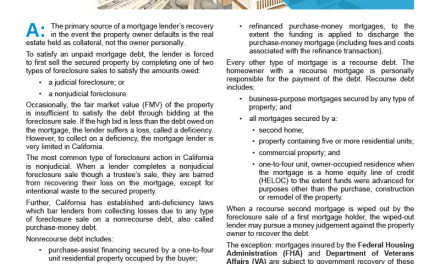$815 million of taxpayer money has gone to mortgage lenders for running at-risk homeowners through the Home Affordable Modification Program (HAMP).
HAMP’s thoughtful aim was to aid homeowners at risk of defaulting or in default on their mortgage. As an incentive to get lenders to participate, the government pays lenders to merely reduce the monthly payments of distressed homeowners, called loan modifications or mods.
The theory goes that reduced monthly payments lower the homeowner’s burden, thus enabling them to retain their home (theoretically). What was overlooked was the elephant in the room – the excess mortgage principal.
HAMP was created to aid three to four million homeowners. In five troublesome years, it has only reached a measly 1.2 million. Worse, while the lenders have kept all of the incentive federal money, a majority of HAMP mod homeowners saw their payments ineffectively drop by less than 10%. No mortgage principal reduction, with very rare exception.
Consequently, a third of homeowners aided by HAMP mods have stopped making payments.
Related article
Automatic loan modifications begin. Will mods nibble at negative equity’s heel?
The federal government has taken steps with the intent to improve HAMP. In its first iteration, initiated in 2009, HAMP gave a flat payment to loan servicers for mods. In June 2012, HAMP was modified to a tiered reward system where higher incentive payments were given to lenders who did more for homeowners. The greater the assistance, the greater the payout to the lender.
Homeowners with HAMP modifications are now showing lower re-default rates than those from 2009 and 2010. Still, 12% of homeowners are still underwater nationally (and over 21% in California) and 27% of those who received permanent modifications under HAMP have defaulted again.
first tuesday insight
HAMP again offers far too little, too late. The government needs to do better to correct their past decades of failed homeownership policies.
HAMP has given lenders over $800 million in taxpayer dollars without reducing the insolvent homeowner’s debt burden. Despite improving HAMP in June 2012, little actual relief beyond minor payment reductions still has yet to be passed on to homeowners.
Further, if and when a borrower actually gets a HAMP modification, it’s always of the extend-and-pretend variety. The excess principal balance on the mortgage is the fundamentally destructive black-hole asset plaguing the borrower. However, it is totally outside the consideration of HAMP incentives. Thus, the underlying disease of negative equity remains uncured.
Related article
The current requirements allow lenders to do little to aid homeowners in return for compensation. HAMP needs to mandate lender performance – a point first tuesday has pushed for some five years now and counting.
Basing lender compensation on a homeowner’s long-term financial health will be a step in the right direction, ensuring lenders actually do what they are incentivized to do (aid distressed homeowners). Currently, lenders only have an incentive to make a payment modification to keep the loan on the books. They have little incentive to see homeowners lifted out of insolvency. However, if the homeowner’s financial stability – solvency – were tied to the lender’s profit, the lender will have an impetus to follow through with homeowners and see tangible improvement.
Ultimately, if we want to see real relief for California’s negative equity homeowners, lenders need to shift focus from monthly payments to principal balances. In California, just over 21% of homeowners are still underwater. By reducing monthly payments, the illusion of relief is invented – but it is just that, an illusion.
HAMP mods don’t merely ignore swollen mortgage balances, they exacerbate them. Under HAMP, homeowners’ actual mortgage debt becomes greater for all the add-ons that extend the life of the loan. Thus, the borrower ends up paying for their mortgage over the life of its term. This leads to justifiable homeowner frustration with the mortgage lender, paving the way for a strategic default as a rational business decision.
Related article
What the housing market needs are fewer modifications and more cramdowns.
This will give the home sales market the lasting jolt it needs to get home sales moving again. Immobility has killed off the massive segment of the California housing market that sells and moves on up into bigger and better replacement housing. You can’t upgrade if you can’t slough off the negative equity albatross from around your neck.
















The article is incorrect. A large % of my clients have received principal reductions. Many have received principal forbearance; a 40-year forbearance at 0% interest is the economic equivalent of about a 95% principal reduction [provided the owner intends to stay], without the potential tax consequences of actual forgiveness.